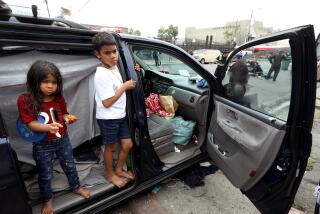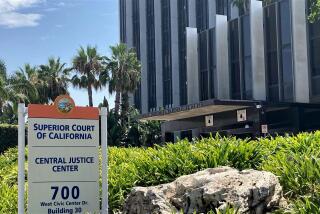Thousands Abused : Street Kids--Philippines’ Agony Grows
- Share via
MANILA — Night was coming on, and Saturnina Peralta was again preparing to send her two sons back into the streets, but 11-year-old Miguel decided he simply could not take it anymore.
For years, Miguel and his six-year-old brother, Ricky, had been forced by their mother--at 30, a veteran prostitute--to beg, to steal and to solicit pedophiles in the seamy streets of Manila’s Ermita tourist district.
Their bodies were covered with hundreds of sores, their heads were deeply scarred, their digestive tracts infested with parasites from their years of living on--and off of--the streets. Ricky’s face was permanently twisted into a grimace; his mother had taught him that this would bring extra pesos. Miguel’s body was racked by a venereal disease.
Flees With Brother
But now Miguel had had enough. He escaped. He bundled up his sickly brother and fled. He made his way through the city to a center for street children opened last year by President Corazon Aquino’s government as part of a campaign to deal with what experts say is the world’s fastest-growing population of abused, abandoned and neglected children.
For Miguel, it was just one more twist in a life-and-death war with the streets. He knew exactly where the center was located. He and his brother had been there before--for nearly three months, until his mother “kidnaped” them last April and took them back to the streets.
Officials at the center say that the two boys will probably be kidnaped again. Their mother, like many impoverished Filipino parents, looks on her offspring as economic assets.
Begging From Gutters
Miguel and Ricky Peralta--their names have been changed--exemplify one of the most acute and most alarming social problems in the Philippines. The authorities estimate that there are 10 million children from impoverished, abusive or exploitative families either living in the streets of this troubled nation or likely to end up there.
Already, more than 100,000 children nationwide have become the street soldiers of beggar masters, pimps, prostitute mothers and unemployed fathers. These children beg from gutters and garbage heaps on street corners where four years ago there were no beggars.
The problem dates from the regime of former President Ferdinand E. Marcos, whose 20-year rule left the country $28 billion in debt, its treasury empty, and the average Filipino with an annual income of $656, the lowest level in two decades. When the street corners of Manila and other major Philippine cities began to fill with beggars, Marcos and his wife, Imelda, who was governor of metropolitan Manila, virtually ignored the problem, except for ordering the beggars arrested.
Aquino has recognized the growing problem. Through a series of radical but little-known decrees, she has promised to rehabilitate the street children. Last December, for example, Aquino issued a decree that empowers the government to seize the children of parents who physically abuse them or force them into prostitution. Government-financed centers for such children are appearing throughout Manila.
But limited government resources and an ineffective government bureaucracy have kept social workers from even scratching the surface of the problem. And sociologists regard the growing number of street children as a frightening sign that the institution of the family--perhaps the last barrier to anarchy here--is beginning to give way. Moreover, the experts say, the problem is expected to get worse.
“If the government figures are correct that . . . we will not return to our economic level of 1981 until 1991, the problem will definitely become worse,” said Leopoldo Moselina, staff director of the U.N. Children’s Fund in Manila, which is attempting to coordinate a large-scale project to help the street children.
Given that harsh economic reality, Moselina added, “It is very unrealistic to think we will be able to get these kids off the streets. The most that can be done through the street children project is basic survival--to help the child survive while he is on the streets.”
Moselina said that to understand the crisis of the street children is to understand the economic crisis facing the Filipino family and the nation as a whole.
“The Filipino child is suffering because his family is suffering and the whole society is suffering,” he said. “The family is now in crisis because the nation is in crisis.”
Sociologist Roselle Leah Rivera, an expert on the problem of street children, said: “Why are thousands of children splattered on the city streets? Over the past years, poverty has grown to massive proportions and more and more Filipino families have been sucked into economic crisis.
“The inability to cope with dwindling income has forced Filipinos to utilize all available labor, particularly children’s labor, to make ends meet. . . . And the extreme difficulty in surviving the demands of a commercialized life has definitely caused undue strains in the Filipino family.”
Recent studies sponsored by the United Nations and the Aquino government have produced statistics that testify to the dimensions of the crisis.
Of the 10 million children classified by the government as in “especially difficult circumstances,” half are described as “exploited.” Nearly 4 million of them are employed in rural areas, most of them pledged as virtual slaves to tenant farm landlords; three-quarters of them are unpaid and the remainder are “engaged in heavy manual work not suited to their age and physique,” according to one study.
More than 1 million other children under the age of 15 are employed illegally in the cities, where they work longer hours and earn 48% less than adults performing the same work.
At least 1% of the population of all major cities--75,000 in the case of Manila--are considered hard-core street children who live on the streets and work as cigarette and flower vendors, beggars, garbage scavengers, pickpockets and shoeshine boys. Their earnings are turned over to their parents or other adults who run street-children rings.
The government concedes that, nationwide, at least 20,000 other children under the age of 18 are fully employed as prostitutes--”the most dehumanizing form of exploitative child labor . . . that distorts values, leads to loss of dignity, self-confidence and anti-social behavior,” the study concluded.
About 2.4 million additional children are considered “victims of armed conflicts,” principally a 17-year Communist insurgency that has left thousands dead and millions of others displaced through military evacuations and rebel offensives.
Included in that figure are the children of an estimated 100,000 people who have been arrested on political charges and the 3,000 believed to have been killed in the years after Marcos declared martial law in 1972.
The fastest-growing category, the studies indicate, is the hard-core street children. The extent of the problem can be seen every day and night in Manila, where poverty, urbanization, overcrowding and economic deterioration have left as many as 70% of the city’s population of 8 million below the poverty line.
Ricky and Miguel Peralta are typical victims of the battle for survival that is fought on Manila’s streets, according to sociologist Rivera, who runs the Lingap Center where the two boys took refuge last week.
“These two children are the principal sources of income for their family,” said Rivera, who was a sociology professor at the University of the Philippines before she joined the center. “Under the (Aquino administration’s) new law, we can get the children, even forcibly. But keeping them is another story, given the desperation of the family.”
Found in Tourist Zone
In the Peraltas’ case, Rivera said, the center’s social workers discovered the two boys last November during one of the center’s routine tours of the Ermita district, a neon-lined tourist zone of go-go bars, strip clubs, prostitutes and beggars.
The district, once labeled “the Sodom and Gomorrah of Asia” by Philippine Roman Catholic Cardinal Jaime Sin, attracts organized “sex tours” from Japan, oil workers on leave from Indonesia and the Persian Gulf and businessmen from throughout the world. Its clubs range from the sophisticated to the sleazy.
In a much-publicized campaign begun last month, Manila Mayor Gemiliano Lopez Jr. declared the district off-limits to children. He announced a 6 p.m.-to-6 a.m. curfew for all children below the age of 18. “The urgent need to protect our children from these proliferating evils leaves me no alternative but to adopt this measure,” the mayor said.
The first two weeks of the campaign were a success, Lopez said. The police filled what Lopez called a “reception center,” in reality a special jail for children, with hundreds of child prostitutes and beggars.
But the curfew turned out to be a new source of income for the police officers who work the Ermita beat.
On a recent evening, three hours after the curfew went into effect, a 15-year-old boy who said his name was Gerry approached a Times reporter standing just eight feet from an on-duty policeman and offered his services for 300 pesos ($15). When the reporter declined and identified himself as a member of the press, the boy openly discussed the failure of the new curfew.
Gerry explained that he had been picked up by the police the previous evening but was released after he paid the patrolman 150 pesos. And enforcement was so lax, he said, that it is still possible for him to serve as many as eight customers in a night, bringing in nearly $100, which he said he turns over to his mother.
“The majority of children who have experienced life in the streets perceive policemen to be symbols of oppression, authority and corruption,” said sociologist Rivera. “We have validated case studies of children who have revealed that policemen, with their names and ranks identified, are actual pimps. How ironic--the very persons supposed to protect are the same ones who actively solicit customers.”
Children Draw Policemen
This harsh reality is reflected in the drawings made by children at Rivera’s center as part of their therapy. Many of the drawings show policemen with their hands thrust out or their weapons drawn.
The center’s rehabilitation strategy is basic, Rivera said. “You talk to the child,” she said. “You don’t shout, and you talk to him like an adult. You hug him. You make sure he bathes once a day and that he knows someone cares about him.”
Finally, she said, “you hope his parents don’t steal him away.”
Perhaps the greatest tragedy at Lingap, cited by international experts as the best program for street children in Manila, is its under-use.
The complex, a former camp for Vietnamese refugees in a suburban slum neighborhood of Manila called Welfareville, is large enough to accommodate 100 children, but there are never more than 50 there.
“Our problem is resources--we don’t have enough staff to handle more children,” Rivera said. “We’ve been crawling here . . . because you have an inefficient bureaucracy at the top.”
Aquino’s government pledged last December that $200,000 would be allocated to run the center, but the money was not appropriated until last week. In the meantime, Rivera and her staff have had to survive on private contributions, which prevented them from hiring a doctor or nurse to care for children who arrive suffering from infected sores, severe intestinal diseases and, occasionally, pneumonia.
Four similar centers planned for other major Philippine cities, where the street-children problem is growing just as fast, have yet to open because the money to finance them has not been released.
Still, Rivera is hopeful, and her hope is symbolized by the children. Some of them put on a spontaneous show the other day for two adult visitors. They sang a Tagalog-language song, and the lyrics went like this:
Every child has a name, and he has rights.
Every child has a place under the sun, rich or poor, white or brown.
Whatever race, the world’s children are brothers.
Every child in the world has a name, and he has his rights.
The only child who was not singing was Ricky Peralta, who sat crookedly on the floor, his body covered with sores, his expression unchanged.
More to Read
Sign up for Essential California
The most important California stories and recommendations in your inbox every morning.
You may occasionally receive promotional content from the Los Angeles Times.










